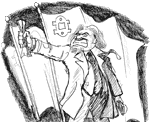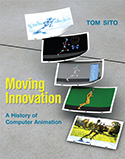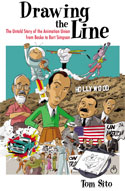“ Tom Sito achieved something of a miracle-- he made a potentially boring "academic" subject fresh, entertaining, and a wonderful read. C'mon--let's face it-- unless you're in the animation industry, or you are the grandson of Sam Gompers, or like to hunt cement foundations for Jimmy Hoffa---- labor history? zzzzzz "WE had a strike in 1928"-- who cares? Go off and "sing solidarity forever", or something.
Ah, but Tom Sito's book is a fantastically interesting read for anyone-- full of anecdotal stories that are at once informative and entertaining. Where else can you read about the day Walt Disney almost got into a fistfight with actor John Garfield?
Sito is a storyteller, and much of the book is don't in a storytelling style-- for example, in speaking of animation mogul Dave Fleischer, Sito says "At the Fleisher studio, when Dave Fleisher put his red light on outside his office,it meant he did not want to be disturbed. That meant either he was working, or, more likely, he was having sex with his secretary or listening to the racetrack calls on his big radio."
There's a serious side as well. Sito details the terrible working conditions in the early days-- strict dress codes, cramped working conditions, low pay. Yet there's also balance in the book. Sito is not trying to tear down anyone's reputation. People like Walt Disney were human, nothing more, nothing less-- and they are also products of their time. Disney was sometimes generous and caring to employees, but he also was a perfectionist who demanded-- and usually got-- 1000 per cent from his workers. A driven individual, he was also a hard-headed businessman who feared unionism would disrupt profits. Sito's book makes it clear that Disney was not the affable Uncle Walt of legend, nor was he a cold-blooded studio tyrant. He was simply a gifted producer with human faults, just like the rest of us.
What makes the book so good? First, Sito is a writer with a passion for history, and as an animator he has an insider's feel for the subject. Sito himself has an impressive resume, including work on picures like Disney's Beauty and the Beast--he was heavily involved in the "Gaston tavern" sequence, for example.
Though union membership is in decline, in the 30s unions did make the workers' lives better. Sito certainly shows this as he details the struggles of the animation unions. The book is great on so many levels-- history, perod detail, entertaining stories. HIGHLY recommended.”
Ah, but Tom Sito's book is a fantastically interesting read for anyone-- full of anecdotal stories that are at once informative and entertaining. Where else can you read about the day Walt Disney almost got into a fistfight with actor John Garfield?
Sito is a storyteller, and much of the book is don't in a storytelling style-- for example, in speaking of animation mogul Dave Fleischer, Sito says "At the Fleisher studio, when Dave Fleisher put his red light on outside his office,it meant he did not want to be disturbed. That meant either he was working, or, more likely, he was having sex with his secretary or listening to the racetrack calls on his big radio."
There's a serious side as well. Sito details the terrible working conditions in the early days-- strict dress codes, cramped working conditions, low pay. Yet there's also balance in the book. Sito is not trying to tear down anyone's reputation. People like Walt Disney were human, nothing more, nothing less-- and they are also products of their time. Disney was sometimes generous and caring to employees, but he also was a perfectionist who demanded-- and usually got-- 1000 per cent from his workers. A driven individual, he was also a hard-headed businessman who feared unionism would disrupt profits. Sito's book makes it clear that Disney was not the affable Uncle Walt of legend, nor was he a cold-blooded studio tyrant. He was simply a gifted producer with human faults, just like the rest of us.
What makes the book so good? First, Sito is a writer with a passion for history, and as an animator he has an insider's feel for the subject. Sito himself has an impressive resume, including work on picures like Disney's Beauty and the Beast--he was heavily involved in the "Gaston tavern" sequence, for example.
Though union membership is in decline, in the 30s unions did make the workers' lives better. Sito certainly shows this as he details the struggles of the animation unions. The book is great on so many levels-- history, perod detail, entertaining stories. HIGHLY recommended.”
-- Eric Niderost, Chabot College
_______________




